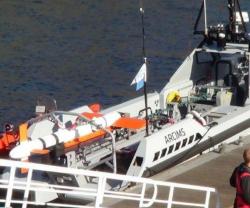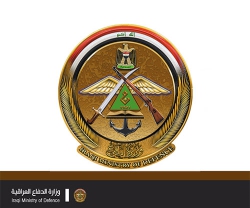NGC’s SABR 5th Gen Capability & New B-2 Satcom System
17.05.2013 North America
Northrop Grumman Corporation's (NGC) Scalable Agile Beam Radar (SABR) designed for the F-16 fighter aircraft recently demonstrated its autonomous, all-environment precision targeting capability, which will enhance the aircraft's mission capabilities.
The capability, known as Auto Target Cueing (ATC), uses high-definition synthetic aperture radar (SAR) images to locate and prioritize targets of interest and display them to the pilot. The active electronically scanned array (AESA) radar architecture allows it to carry out this function while performing other tasks at the same time.
SABR is an affordable, multifunction AESA radar designed specifically for F-16 retrofit. SABR provides longer detection and tracking ranges, high-resolution SAR maps for all-environment precision targeting, interleaved mode operations for greater situational awareness and greater reliability.
Northrop Grumman has nearly four decades of F-16 radar development and integration experience, and has delivered more than 6,000 fire control radars to U.S. and international air forces. The company also supplies the AESA fire control radars for the F-16 Block 60, F-22 and F-35 aircraft.
Meanwhile, NGC has successfully completed a ground demonstration of a communication system that would allow the U.S. Air Force's B-2 stealth bomber to operate with the Advanced Extremely High Frequency (AEHF) satellite network (photo).
The end-to-end tests prove the maturity of the technologies required to begin full-scale development of a new satellite communications system.
Northrop Grumman conducted the demo April 18 at its Space Park facility in Redondo Beach. It included a prototype active electronically scanned array (AESA) antenna developed by the company, a government-furnished Navy Multi-band Terminal and an AEHF engineering model payload.
Northrop Grumman is the Air Force's prime contractor for the B-2, the flagship of the nation's long-range strike arsenal, and one of the world's most survivable aircraft.
NGC conducted the tests at EHF frequencies using secure transmission techniques, added Tirabassi. Her test team plans to repeat the laboratory demos in the near future using other B-2 satellite terminal candidates, including a government-furnished Family of Beyond Line-of-Sight Terminal.
The AEHF engineering model payload is representative of EHF satellite payloads currently on orbit. It is used by the U.S. Air Force, Navy and Army to test new EHF satellite terminals prior to testing them with operational satellites.
Earlier this year, Northrop Grumman validated the performance of the AESA antenna on instrumented test ranges. The tests verified the antenna's performance over its entire transmit and receive frequency band, and over its required range of scan angles. The AESA antenna will allow the B-2 to send and receive battlefield information at data rates significantly faster than its current satellite communications system.
Following completion of the current AEHF laboratory demos, Northrop Grumman plans to demonstrate the ability of the AESA antenna and a terminal to communicate directly "over the air" with an operational AEHF satellite.
The B-2 is the only long-range, large-payload U.S. aircraft that can penetrate deeply into access-denied airspace, and the only combat-proven stealth platform in the current U.S. inventory. In concert with the Air Force's air superiority fleet, which provides airspace control, and the Air Force's tanker fleet, which enables global mobility, the B-2 can help protect U.S. interests anywhere in the world.
The B-2 can fly more than 6,000 nautical miles unrefueled and more than 10,000 nautical miles with just one aerial refueling, giving it the ability to reach any point on the globe within hours.
The capability, known as Auto Target Cueing (ATC), uses high-definition synthetic aperture radar (SAR) images to locate and prioritize targets of interest and display them to the pilot. The active electronically scanned array (AESA) radar architecture allows it to carry out this function while performing other tasks at the same time.
SABR is an affordable, multifunction AESA radar designed specifically for F-16 retrofit. SABR provides longer detection and tracking ranges, high-resolution SAR maps for all-environment precision targeting, interleaved mode operations for greater situational awareness and greater reliability.
Northrop Grumman has nearly four decades of F-16 radar development and integration experience, and has delivered more than 6,000 fire control radars to U.S. and international air forces. The company also supplies the AESA fire control radars for the F-16 Block 60, F-22 and F-35 aircraft.
Meanwhile, NGC has successfully completed a ground demonstration of a communication system that would allow the U.S. Air Force's B-2 stealth bomber to operate with the Advanced Extremely High Frequency (AEHF) satellite network (photo).
The end-to-end tests prove the maturity of the technologies required to begin full-scale development of a new satellite communications system.
Northrop Grumman conducted the demo April 18 at its Space Park facility in Redondo Beach. It included a prototype active electronically scanned array (AESA) antenna developed by the company, a government-furnished Navy Multi-band Terminal and an AEHF engineering model payload.
Northrop Grumman is the Air Force's prime contractor for the B-2, the flagship of the nation's long-range strike arsenal, and one of the world's most survivable aircraft.
NGC conducted the tests at EHF frequencies using secure transmission techniques, added Tirabassi. Her test team plans to repeat the laboratory demos in the near future using other B-2 satellite terminal candidates, including a government-furnished Family of Beyond Line-of-Sight Terminal.
The AEHF engineering model payload is representative of EHF satellite payloads currently on orbit. It is used by the U.S. Air Force, Navy and Army to test new EHF satellite terminals prior to testing them with operational satellites.
Earlier this year, Northrop Grumman validated the performance of the AESA antenna on instrumented test ranges. The tests verified the antenna's performance over its entire transmit and receive frequency band, and over its required range of scan angles. The AESA antenna will allow the B-2 to send and receive battlefield information at data rates significantly faster than its current satellite communications system.
Following completion of the current AEHF laboratory demos, Northrop Grumman plans to demonstrate the ability of the AESA antenna and a terminal to communicate directly "over the air" with an operational AEHF satellite.
The B-2 is the only long-range, large-payload U.S. aircraft that can penetrate deeply into access-denied airspace, and the only combat-proven stealth platform in the current U.S. inventory. In concert with the Air Force's air superiority fleet, which provides airspace control, and the Air Force's tanker fleet, which enables global mobility, the B-2 can help protect U.S. interests anywhere in the world.
The B-2 can fly more than 6,000 nautical miles unrefueled and more than 10,000 nautical miles with just one aerial refueling, giving it the ability to reach any point on the globe within hours.
Latest news
Latest events
Doha International Maritime Defence Exhibition & Conference (DIMDEX 2026)
19 - 22 Jan 2026Doha - QatarUMEX – SimTEX
20 - 22 Jan 2026ADNEC Centre Abu Dhabi, - United Arab EmiratesWorld Defense Show (WDS) 2026
08 - 12 Feb 2026Riyadh - Saudi ArabiaSAHA EXPO International Defence & Aerospace Exhibition
05 - 09 May 2026İstanbul Expo Center - Turkey






















